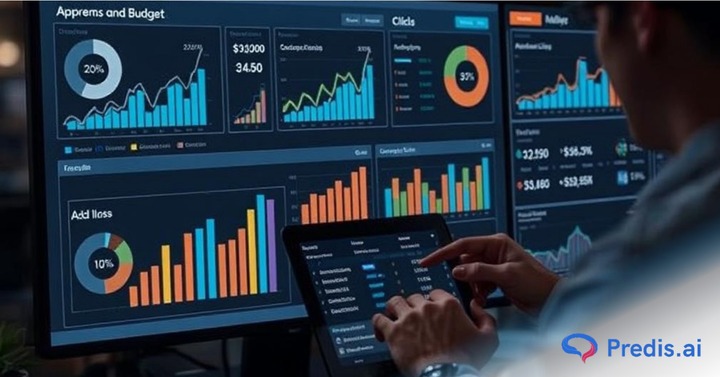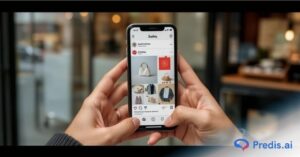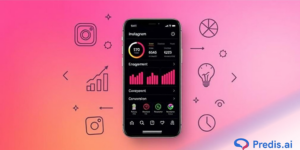“Marketing without data is like driving with your eyes closed,” as Dan Zarrella wisely said.
You’re pouring money into ads but need to know if they’re reaching the right people or, worse, if they’re working. Nowadays, trends shift faster than ever, and guesswork simply doesn’t cut it.
Therefore, marketing professionals realized there needs to be a shift towards data-driven marketing. They’re recognizing the power of data to monitor their ad spend and optimize campaigns.
This shift towards data-driven marketing equips you with the tools to monitor ad budgets. With data, you can transform your marketing efforts. They become laser-focused machines, generating a return on investment.
So get ready to unlock the secrets of effective ad spend monitoring. This guide delves into crucial metrics and explores tracking methods to analyze your performance like a pro.
Importance of Monitoring Ad Budget
So, why is it so important to monitor ad budgets?
Here’s a reality check: advertising strategies may be complex. There are several variables at play, ranging from the platforms you use to the target demographic you contact. With adequate monitoring, it is easier to keep track of your expenditures.
Here are some strong reasons why tracking your ad expenditure is a must:
- You may find locations where your cash is being spent heavily by tracking your ad spend. This allows you to refine your efforts and create more significant profits.
- Data from your ad expenditure tells a tale about what works and what doesn’t. Use this information to make sound judgments regarding your advertising approach.
- Monitor your ad budget to find areas where your advertising could be producing the required results. It also enables you to eliminate wasteful expenses and redirect them to more successful techniques.
- Tracking your ad expenditure gives an understanding of your target audience. This data comprises their actions and responses to your campaigns.
- Monitoring your ad budget allows you to keep ahead of trends and change your plans to remain competitive.
Understanding Ad Budget and ROI
Now that we’ve established the significance of tracking your ad budget, let’s examine the two major players in this game: ad budget and ROI.
What is an Ad Budget?
The ad budget is the money you will spend to achieve your advertising objectives. This funding can be allocated through various sources. These channels may include social media advertising and search engine marketing, as well as classic means such as print or broadcast advertisements.
What is ROI?
Return on investment represents a measure that allows you to assess the performance of your advertising campaigns. By tracking key performance indicators, it simply calculates the profit you make for each dollar spent on advertising. By tracking key performance indicators, it simply calculates the profit you make for each dollar spent on advertising.
Here’s a breakdown of the return on investment formula:
ROI = (Revenue Generated from Ads / Ad Cost) x 100%
In simple terms, the higher your ROI, the better your campaign is doing. A good ROI shows that your advertisements generate more cash than the ad cost. A negative ROI indicates that you are spending more than you make.
Relationship Between Ad Budget and ROI
Understanding how your ad spend affects ROI is critical to your organization. When you distribute resources across platforms, you can expect excellent results.
Additionally, assessing and improving your advertising is critical. A larger budget allows you to reach more individuals, enhance engagement, and drive conversions. However, spending should be balanced with outcomes.
Finally, use data to inform your decisions and respond to market developments. This technique will help you get the most out of your investment and maintain consistent development.
Key Metrics to Monitor Ad Budget
Okay, so we understand the significance of tracking our ad expenditure and the correlation it has with ROI. Let’s examine the primary data you should track to monitor ad budget. These stats help you optimize your campaigns and get a more significant ROI.
Here are some of the key metrics you should be tracking to monitor ad budget for your ad campaigns:
1. Click-Through Rate (CTR)
CTR refers to the percentage of individuals who notice and click on your ad. It reveals how your ad captures viewers’ interest and entices them to learn more about your product or service.
CTR = (Number of Clicks) / (Number of Impressions) multiplied by 100%
A high CTR indicates that your ad is relevant and exciting for your target demographic. A low CTR may imply that you need to improve your targeting or rethink your ad copy.
Click-Through Rate (CTR) Example
Consider marketing your cleaning goods on a sustainability website (5,000 impressions). Your advertisement attracts attention, but not enough clicks lead to purchases. Let’s examine how these data convert into ROI.
- Clicks: 120
- Impressions: 5,000
- Cost per Click (CPC): $0.50
- Calculating Click-Through Rate (CTR)
- CTR = (Clicks / Impressions) x 100%.
- CTR = (120 clicks / 5,000 impressions) x 100% = 2.4%.
2. Cost Per Click (CPC)
The cost you incur each time a user clicks on your advertisement is shown by the CPC. Low cost-per-click (CPC) is a crucial factor when determining an effective marketing budget, as it helps maximize return on ad spend and allows for reaching a wider audience within budget constraints. On platforms that use pay-per-click (PPC) advertising models, this works well.
Formula: CPC = (total ad spend)/(number of clicks)
A low CPC is good since it indicates that you are receiving clicks at a fair ad cost. A high CPC may indicate that you need to modify your bids or targeting to reach your target audience.
Consider launching a search engine ad campaign for your new line of organic beauty goods. You’ve set a $1,000 budget to attract potential buyers looking for terms like “natural skincare” or “eco-friendly cosmetics.” But how much do you pay each time someone clicks on your ad? This is where cost-per-click (CPC) comes in.
Cost Per Click (CPC) Example
Let’s imagine your ad campaign gets 400 hits in the beauty sector. Here’s how you can determine your CPC.
- Total Ad Spend: $1,000
- Number of Clicks: 400
- CPC: ($1,000 Total Spend) / (400 Clicks) = $2.50 per click
In this case, the CPC is $2.50. This is a typical CPC range for the beauty business on search engines. It signifies that you are receiving clicks from an interested target audience at a reasonable ad cost.
3. Conversion Rate
The conversion rate is the percentage of individuals who click on your ad and complete the targeted activity. These might include completing a purchase, subscribing to a newsletter, or downloading a white paper. It demonstrates your ad’s effectiveness in driving the desired outcome.
Formula: Conversion Rate = (Number of Conversions)/(Number of Clicks) x 100%
A high conversion rate shows that your ad motivates viewers to take the following action. A poor conversion rate entails improving your landing page or ad language to better correspond with user intent.
Conversion Rate Example
Imagine you’re running an internet ad campaign for a new product. Your ad receives 1,000 hits, but just 50 people purchase anything. Here’s where the conversion rate kicks in. It informs you what proportion of clicks result in a sale.
- Sales (Conversions) = 50
- Clicks = 1,000
- Conversion Rate = (Number of Sales) / (Number of Clicks) x 100%
- Conversion Rate = (50 / 1,000) x 100% = 5%
A 5% conversion rate means 5% of people who clicked your ad became paying customers. This can be a good starting point, but there’s always room to improve by optimizing your ad and landing page.
4. Cost Per Conversion (CPA)
CPA goes beyond CPC by indicating how much you pay to capture each new client or lead via your ad campaign. It’s an essential indicator to monitor ad budgets. It determines the overall effectiveness of your advertising campaigns in generating sales or sign-ups.
Formula: CPA = (total ad spend) / (number of conversions).
A low CPA is typically desired since it indicates you are getting consumers or leads at a reasonable cost. A high cost-per-acquisition may signal the need to reconsider your targeting approach. Alternatively, you may tweak your conversion funnel to improve the user experience.
Cost Per Conversion (CPA) Example
Assume you’re launching a social media advertising campaign to promote your new e-commerce website selling fitness clothing. You give the campaign a total budget of $1,000, which results in 50 sales.
Here’s how to calculate your CPA using the formula:
- Total Ad Spend = $1,000
- Number of Conversions (Sales) = 50
- CPA = Total Ad Spend / Number of Conversions CPA = $1,000 / 50 = $20
In this scenario, your CPA is $20. This means that for every sale you acquired through this social media ad campaign, you paid an average of $20.
5. Return on Ad Spend (ROAS)
ROAS goes beyond ROI by accounting for the income earned from ad expenditures. It calculates the amount of money you generate for every dollar spent on advertising campaigns.
Formula: ROAS = (Total Revenue Generated from Ads)/(Total Ad Spend)
A high ROAS suggests that your adverts provide a considerable investment return. A low ROAS may indicate that you need to refine your efforts to generate more sales or modify your pricing approach to increase profits.
Return on Advertising Spend (ROAS) Example
Using the CPA calculation as an example, consider a fitness gear e-commerce shop conducting a social media marketing campaign:
- Total Ad Spend = $1,000
- Number of Conversions (Sales) = 50
However, for ROAS, we need to consider the total Revenue generated from these sales. Let’s assume:
- Average Order Value (AOV) = $100 (This is the average amount target audience spend per order)
Therefore:
- Total Revenue Generated from Ads = Number of Conversions * AOV
- Total Revenue Generated from Ads = 50 sales * $100/sale = $5,000
Now we can calculate the ROAS:
- ROAS = Total Revenue Generated from Ads / Total Ad Spend
- ROAS = $5,000 / $1,000 = 5
In this example, the ROAS is 5. This means that for every dollar spent on the social media ad campaign, the store generated $5 in Revenue. A ROAS of 5 is generally considered a good return on investment for e-commerce businesses.
Here’s how to read the ROAS:
- High ROAS: A ROAS of 5 indicates a successful campaign with a significant return. The store is profiting from its advertising investment.
- Low ROAS: A lower ROAS may indicate opportunities for improvement. The shop might examine various things to boost sales. Ad targeting, conversion funnel optimization, and pricing strategy are just a few of the aspects to consider. Each of these tactics has the potential to boost the store’s return on advertising spend.
6. Customer Acquisition Cost (CAC)
CAC is a broader metric that includes all marketing and sales costs associated with gaining a new client. It extends beyond ad spending to encompass expenses such as website development, content marketing, and sales force pay.
Formula: CAC = (Total Customer Acquisition Costs)/(Number of New Customers Acquired)
Understanding your CAC allows you to assess the profitability of your client acquisition activities. A high CAC may involve researching more cost-effective marketing techniques or fine-tuning your sales funnel to increase conversion rates.
Customer Acquisition Cost (CAC) Example
Let’s switch gears and consider a mobile app with in-app purchases as our example. Here’s a breakdown of potential customer acquisition costs:
- App Store Optimization (ASO): $500 per month (ongoing cost)
- Social Media Marketing: $2,000 per month (ongoing cost)
- Influencer Marketing Campaign: $10,000 (one-time cost)
- Public Relations (PR): $3,000 per month (ongoing cost for 3 months)
Similar to the previous example, this is a simplified breakdown for illustrative purposes.
Here’s how to calculate the total customer acquisition costs for three months:
- Total Customer Acquisition Costs = ASO + Social Media Marketing + Influencer Marketing Campaign + PR (for the period)
- Total Customer Acquisition Costs = $500/month * 3 months + $2,000/month * 3 months + $10,000 + $3,000/month * 3 months
- Total Customer Acquisition Costs = $1,500 + $6,000 + $10,000 + $9,000
- Total Customer Acquisition Costs = $26,500
- Let’s assume the marketing efforts resulted in 500 new app downloads with in-app purchases during the 3 months.
- Number of New Customers Acquired (with in-app purchases) = 500
Now we can calculate the CAC:
- CAC = Total Customer Acquisition Costs / Number of New Customers Acquired
- CAC = $26,500 / 500 = $53
Interpreting the CAC:
A mobile app’s CAC of $53 is a positive indicator. This is especially true if in-app purchases provide a high average income per user.
Customer profitability may be determined by evaluating ARPU and CAC. If the ARPU is much greater than $53, gaining subscribers at this price may be viable.
This example demonstrates how CAC may be applied outside regular product sales. It may be used for a variety of business models, including freemium applications, in-app purchases, and subscriptions.
Struggling to see results from your mobile ads? Predis.ai’s mobile ad maker can help! Easily create high-performing creatives that drive clicks and conversions. Try it out for free!”
7. Lifetime Value (LTV)
LTV estimates a customer’s total Revenue from their relationship with the business. It goes beyond a single purchase. It considers the potential for repeat business and upselling opportunities.
Understanding your LTV helps you determine if your customer acquisition costs are sustainable. A high LTV relative to CAC indicates a healthy business model.
Lifetime Value (LTV) Example
Let’s explore LTV using a subscription box service example. Here’s how we can estimate it:
1. Average Customer Revenue (ARPU)
Calculate the average monthly Revenue generated by a customer. This might include the subscription fee and additional product purchases within the box.
For instance, let’s assume the average monthly Revenue per customer is $50.
2. Customer Retention Rate
Determine the percentage of customers renewing their subscriptions after the initial period (usually a month).
The customer retention rate is 70%, meaning 70% of customers continue their subscriptions after the first month.
3. Average Customer Lifespan
Estimate the average duration a customer subscribes to the service (in months).
For example, suppose the average customer lifespan is 12 months.
Here’s a common approach to estimating LTV:
- LTV = ARPU * Average Customer Lifespan * Customer Retention Rate
- LTV = $50/month * 12 months * 70%
- LTV = $600 x 0.7 = $420
Interpretation
In this case, the calculated LTV is $420. This indicates that the subscription box business may expect an average of $420 from each consumer over their membership period.
A high LTV relative to CAC is desired. The company model is likely viable if the CAC is less than $420. The income from a single client (LTV) can pay the CAC while generating profit.
Customer behavior varies. Hence, LTV is an assumed average number. To get a complete picture, follow client groups and assess their LTVs.
8. Impressions and Reach
Impressions count the number of times your ad is displayed, regardless of whether anyone clicks. Reach indicates the number of unique people who saw your advertisement at least once.
Impressions and reach give information about the overall exposure of your ad campaign. However, they only sometimes reflect engagement or efficacy. To get a full view, compare them to metrics such as CTR and conversion rate.
Feeling like your Twitter ads aren’t getting the engagement you deserve? Predis.ai’s Twitter ad maker designs targeted ads that resonate with your audience and boost brand awareness. Give it a try!
Impressions and Reach Example
You are marketing a new fitness app on a prominent fitness website.
Your banner ad is shown throughout the website 20 times on each article page. If the website has 10,000 daily visitors who see an average of three articles each, the total number of impressions is 60,000 (20 impressions per page x three pages per visitor x 10,000 visits).
However, if those 10,000 visitors only represent 4,000 unique users (some of whom return many times), that is your reach.
9. Engagement Rate
Engagement rates vary by platform, but they typically indicate how actively users interact with your ad. This might include behaviors such as likes, comments, shares, and retweets.
A high engagement rate indicates that your ad connects with your target demographic and generates interest. A low interaction rate may imply that you need to improve the visual attractiveness of your ad or change the text to be more relevant.
₹Engagement Rate Example
You post a funny video ad for a cat toy company on Instagram.
The video gets 10,000 views (impressions) but only 1,200 likes, comments, or shares. This translates to a 12% engagement rate (1,200 engagements / 10,000 impressions). A high engagement rate like this suggests the video is entertaining and resonates with cat lovers.
10. Bounce Rate
The bounce rate is the percentage of visitors who land on your landing page without taking any action. After clicking on your ad, they depart without taking any action.
A high bounce rate may indicate that your landing page needs to meet user expectations or have a clear call to action. Monitoring bounce rate allows you to optimize your landing page for higher conversion rates.
Bounce Rate Example
You’re running an email campaign for a travel business that offers a discount on weekend vacations.
You send an email to 5,000 subscribers, and 1,000 click the link to view the precise locations. However, 600 visitors exit the travel agency’s website without viewing packages or contacting them. This yields a 60% bounce rate (600 persons departing out of 1,000 visitors).
A high bounce rate here might suggest that the email’s subject line or preview text overpromised a luxury experience that the website’s weekend vacation selections do not provide. You may enhance the email by emphasizing cheap places and including appealing photographs of low-cost vacation destinations.
Conclusion
A data-driven approach is required to monitor ad budget and maximize return on investment. This is a critical initial step: track key performance indicators (KPIs) throughout your campaign.
These KPIs provide vital insights. A high conversion rate indicates that clicks are turning into sales. This shows that your advertisement is effective with your target demographic.
A low cost per click (CPC) shows you get clicks at a reasonable price. Finally, a positive return on ad spend (ROAS) indicates that your campaign is delivering a good return on investment.
By watching these indicators and studying their data, you can constantly improve your ad approach. This enables targeted adjustments, ensuring that your ad expenditure is focused on maximizing return on investment.
Take control of your marketing efforts with Predis.ai! Sign up for a free trial today and see the difference data-driven marketing can make!















